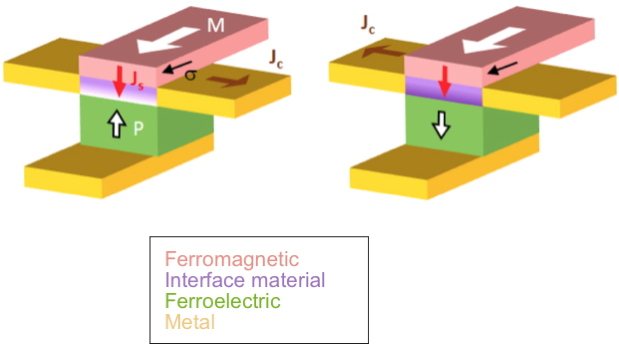Electron spin, a quantum property par excellence, is at the heart of the magnetism of materials as well as a technology called spintronics, which exploits
spin currents in addition to the charge currents used in conventional electronics. After revolutionizing digital storage with magnetic hard disks, spintronics could play an important role in making new processors that surpass current silicon-based technology. To generate and detect spin currents, spintronics traditionally uses ferromagnetic materials in which the spins are all aligned in the same direction (
spin up or
spin down). Ferromagnetism has the advantage of giving spintronic devices a
non-volatile character, which can reduce the overall energy cost of the devices. However, the energy required to reverse the magnetization by application of a magnetic field or electric current remains significant.
Researchers from our institute have developed, in collaboration with the CNRS/Thales Joint Physics Unit, a new approach to generate and detect spin currents by exploiting the particular electronic properties present at the interface between two non-magnetic materials. In these systems, the injection of a charge current in a given direction generates spins in a transverse direction; reciprocally, the injection of spins in one direction gives rise to a charge current in the transverse direction. The way in which spin and charge currents are thus interconverted (and in particular their sign) is determined by the nature of the interface.
By giving these interfaces a ferroelectric character, the researchers were able to control the sign of interconversion
via electrical polarization. To do this, they applied a strong electric field to induce a ferroelectric character to the oxide used, obtaining for the first time a
non-volatile electrical control of the conversion between charge current and spin current. This opens up the possibility of encoding the information in the polarization of the ferroelectric element, and using spin-charge conversion to read this polarization state.
This work paves the way for spintronic devices in which the non-volatility would be provided not by ferromagnetism but by ferroelectricity, and for which the electrical consumption would thus typically be reduced by a factor of 1000.

Example of a device made possible thanks to the results obtained by the researchers. A ferromagnetic material is used to generate a vertical spin current
Js and injecting it into an interface material in which it is converted into a lateral
Jc charge current. Les spins
σ are represented by the small black arrow and their direction is fixed by the direction of magnetization of the ferromagnetic material
M represented by the big white arrow. Traditionally, to change the sign of the charge current produced, the magnetization of the ferromagnetic must be reversed by applying a magnetic field or a strong current to it. Here, this is achieved by reversing the polarization
P of the ferroelectric material acting on the interface by means of an electric field.
Spin-polarized current: an electric current passing through a ferromagnetic material will see its proportion of spin down and spin up electrons changed. These electrons are said to be spin-polarized, like photons going through a polarizer. By this means, we can inscribe information in the spin of the electrons. In a non-magnetic material, a current can also be spin-polarized by the coupling of orbital and spin angular momentum, the spin-orbit coupling..
Non-volatility: conservation of data in the absence of a power supply.